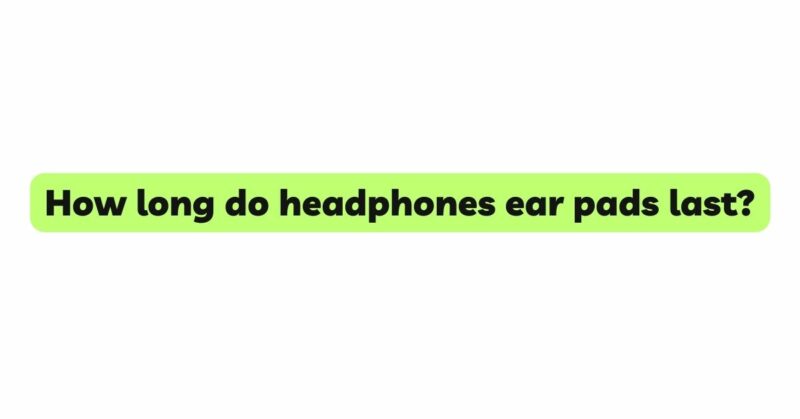Headphones have become an indispensable part of our daily lives, providing us with a personal audio oasis in a noisy world. One crucial aspect of headphones’ performance and comfort lies in their ear pads—the soft cushions that rest against our ears. However, like all components subject to wear and tear, ear pads have a limited lifespan. In this article, we will explore the factors influencing the longevity of ear pads, signs indicating their need for replacement, and essential maintenance tips to extend their life, ensuring an optimal audio experience for longer.
Factors Affecting the Lifespan of Ear Pads:
- Material Quality: The quality of materials used in the construction of ear pads plays a significant role in determining their durability. Premium-grade ear pads, made from memory foam, genuine leather, or high-quality synthetic leather, tend to last longer than those with cheaper materials. These premium materials are not only more resistant to wear but also provide enhanced comfort and sound isolation.
- Frequency and Duration of Use: The more frequently and extensively headphones are used, the faster their ear pads will deteriorate. Daily, prolonged use for extended listening sessions or professional purposes accelerates wear and tear. Conversely, occasional or moderate use extends the lifespan of the ear pads.
- Maintenance and Care: Proper care and maintenance are crucial to preserving the condition of ear pads. Regularly cleaning the ear pads, removing dirt and oils accumulated from contact with the skin, can significantly extend their life. Neglecting cleaning can lead to material degradation and potential damage over time.
- User Habits: Individual user habits can affect the longevity of ear pads. Factors such as how forcefully the headphones are placed on or removed from the ears, whether the headphones are left hanging around the neck when not in use, and exposure to external elements all play a role in the wear and tear of ear pads.
- Climate and Environment: Environmental factors like temperature, humidity, and exposure to sunlight can impact the condition of ear pads. Extreme temperatures and high humidity can cause materials to degrade more rapidly, while prolonged exposure to sunlight may fade or crack certain materials.
Signs Indicating the Need for Replacement:
- Visible Wear and Tear: The most apparent sign that ear pads require replacement is visible wear and tear. Cracks, tears, or peeling of the surface material indicate that the ear pads have reached the end of their usable life. Worn-out ear pads not only compromise comfort but can also negatively impact sound isolation and audio performance.
- Loss of Cushioning: Earpads are designed to provide cushioning between the headphone’s driver and the user’s ears. When they lose their plushness and become flattened or compressed, the headphones may start causing discomfort and pressure points during extended listening sessions.
- Reduced Noise Isolation: One of the primary functions of ear pads is to create a seal around the ears, isolating external noise and enhancing the listening experience. As ear pads age, they may lose their ability to form an effective seal, leading to reduced noise isolation and diminished audio quality.
- Change in Sound Quality: While ear pads themselves may not significantly alter the headphone’s sound signature, worn-out or damaged ear pads can impact sound quality indirectly. Loss of proper seal and cushioning can affect bass response, soundstage, and overall clarity, resulting in an unsatisfactory listening experience.
Maintenance Tips to Extend Ear Pad Lifespan:
- Regular Cleaning: Clean your ear pads regularly using a soft cloth or cotton pad dampened with a mild cleaning solution. Avoid using harsh chemicals or excessive water, as they may damage the materials. Cleaning not only preserves the ear pads’ appearance but also prevents dirt and oil buildup that can lead to premature wear.
- Store Properly: When not in use, store your headphones in a clean and dry environment, preferably in a case or pouch designed to protect them. Avoid hanging the headphones around your neck when not listening, as this can strain the ear pads and the headband.
- Rotate Ear Pads: If your headphones allow for it, consider rotating the ear pads occasionally. This ensures more even wear and extends the overall lifespan of the ear pads.
- Invest in Replacement Ear Pads: Manufacturers often provide replacement ear pads designed specifically for their headphone models. Invest in high-quality replacement pads to maintain optimal comfort and audio performance. Authentic replacements ensure a perfect fit and are likely to offer similar characteristics to the original ear pads.
Conclusion:
The lifespan of headphones’ ear pads is influenced by various factors, including material quality, usage frequency, maintenance, user habits, and environmental conditions. While ear pads will eventually need replacement, their longevity can be extended through proper care and responsible use. Being attentive to signs of wear and tear, such as visible damage, loss of cushioning, reduced noise isolation, or changes in sound quality, will guide you in determining when it’s time for replacement.
By implementing regular cleaning routines and storing headphones properly when not in use, you can preserve the ear pads’ condition and, consequently, the audio performance and comfort they provide. Investing in high-quality replacement ear pads ensures that your headphones continue to deliver an enjoyable audio experience for an extended period, allowing you to savor the soundtracks of life without compromise.


